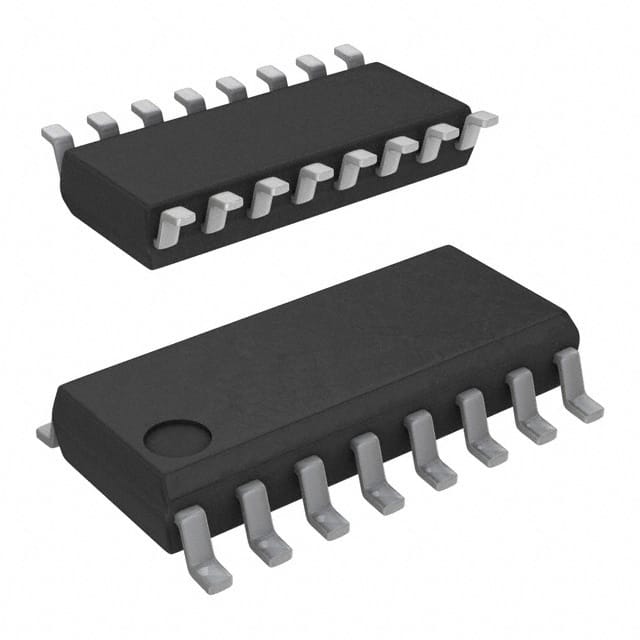CD74HC4051ME4
Product Overview
- Category: Integrated Circuit (IC)
- Use: Multiplexer/Demultiplexer
- Characteristics: High-speed CMOS logic, 8-channel analog multiplexer/demultiplexer
- Package: SOIC (Small Outline Integrated Circuit)
- Essence: Analog switch
- Packaging/Quantity: Tape and Reel, 2500 units per reel
Specifications
- Supply Voltage Range: 2V to 6V
- On-State Resistance: 80Ω (typical) at VCC = 4.5V
- Channel-to-Channel Crosstalk: -70dB (typical) at VCC = 4.5V
- Operating Temperature Range: -40°C to +85°C
- Input Capacitance: 10pF (typical)
- Output Capacitance: 10pF (typical)
Detailed Pin Configuration
The CD74HC4051ME4 has a total of 16 pins. The pin configuration is as follows:
- S0: Channel Select Input 0
- S1: Channel Select Input 1
- S2: Channel Select Input 2
- E: Enable Input
- Z: Common Output/Input
- Y0: Channel 0 Output/Input
- Y1: Channel 1 Output/Input
- Y2: Channel 2 Output/Input
- GND: Ground
- Y3: Channel 3 Output/Input
- Y4: Channel 4 Output/Input
- Y5: Channel 5 Output/Input
- VCC: Positive Power Supply
- Y6: Channel 6 Output/Input
- Y7: Channel 7 Output/Input
- NC: No Connection
Functional Features
- 8-channel analog multiplexer/demultiplexer
- Low power consumption
- High-speed switching
- Break-before-make switching action
- Wide operating voltage range
Advantages and Disadvantages
Advantages: - Versatile multiplexing/demultiplexing capabilities - Low power consumption - High-speed operation - Wide operating voltage range
Disadvantages: - Limited number of channels (8 channels) - Relatively high on-state resistance
Working Principles
The CD74HC4051ME4 is a CMOS analog multiplexer/demultiplexer IC. It allows the selection of one input from multiple inputs to be routed to a common output. The channel selection is controlled by the S0, S1, and S2 pins. The E pin enables or disables the device.
When a specific channel is selected, the corresponding Yx pin becomes the output and the remaining Yx pins are in the high-impedance state. The Z pin serves as both the common input and output terminal.
The CD74HC4051ME4 operates based on the break-before-make principle, ensuring that there is no short circuit during channel switching.
Detailed Application Field Plans
The CD74HC4051ME4 finds applications in various fields, including:
- Audio and Video Signal Routing: It can be used to switch audio and video signals between different sources and destinations.
- Data Acquisition Systems: It enables the selection of different sensors or signal sources for data acquisition purposes.
- Communication Systems: It can be utilized for channel selection in communication systems, such as frequency division multiplexing.
- Test and Measurement Equipment: It allows the routing of test signals to different measurement instruments.
- Industrial Control Systems: It facilitates the selection of different control signals in industrial automation applications.
Detailed and Complete Alternative Models
Some alternative models to the CD74HC4051ME4 include:
- CD4051B: 8-channel analog multiplexer/demultiplexer, DIP package
- CD74HC4067: 16-channel analog multiplexer/demultiplexer, SOIC package
- ADG508A: 8-channel analog multiplexer/demultiplexer, TSSOP package
- SN74HC151: 8-input multiplexer, DIP package
These alternative models offer similar functionality but may have different specifications and pin configurations.
Word count: 437 words
Senaraikan 10 soalan dan jawapan biasa yang berkaitan dengan aplikasi CD74HC4051ME4 dalam penyelesaian teknikal
Sure! Here are 10 common questions and answers related to the application of CD74HC4051ME4 in technical solutions:
Q1: What is CD74HC4051ME4? A1: CD74HC4051ME4 is a multiplexer/demultiplexer integrated circuit (IC) that allows multiple analog or digital signals to be selected and routed to a single output.
Q2: What is the purpose of CD74HC4051ME4? A2: The purpose of CD74HC4051ME4 is to enable signal routing and selection in various applications, such as audio/video switching, data acquisition systems, communication systems, and more.
Q3: How many channels does CD74HC4051ME4 have? A3: CD74HC4051ME4 has 8 channels, which means it can select and route up to 8 different input signals to a single output.
Q4: What is the voltage range supported by CD74HC4051ME4? A4: CD74HC4051ME4 supports a wide voltage range from 2V to 10V, making it compatible with various logic families and power supply voltages.
Q5: Can CD74HC4051ME4 handle both analog and digital signals? A5: Yes, CD74HC4051ME4 can handle both analog and digital signals, allowing for versatile signal routing in mixed-signal applications.
Q6: How does CD74HC4051ME4 achieve signal selection? A6: CD74HC4051ME4 uses control signals to select one of the input channels and route it to the output. The control signals determine which channel is active at any given time.
Q7: What is the maximum frequency supported by CD74HC4051ME4? A7: CD74HC4051ME4 can handle frequencies up to 50 MHz, making it suitable for high-speed signal routing applications.
Q8: Can CD74HC4051ME4 be cascaded to increase the number of channels? A8: Yes, multiple CD74HC4051ME4 ICs can be cascaded together to increase the number of channels and enable selection of a larger number of input signals.
Q9: Does CD74HC4051ME4 have built-in protection features? A9: Yes, CD74HC4051ME4 has built-in ESD (electrostatic discharge) protection on all inputs and outputs, ensuring robustness against static electricity.
Q10: What is the package type of CD74HC4051ME4? A10: CD74HC4051ME4 is available in a standard 16-pin SOIC (Small Outline Integrated Circuit) package, which is commonly used in electronic circuits.
Please note that these answers are general and may vary depending on the specific application and requirements.


